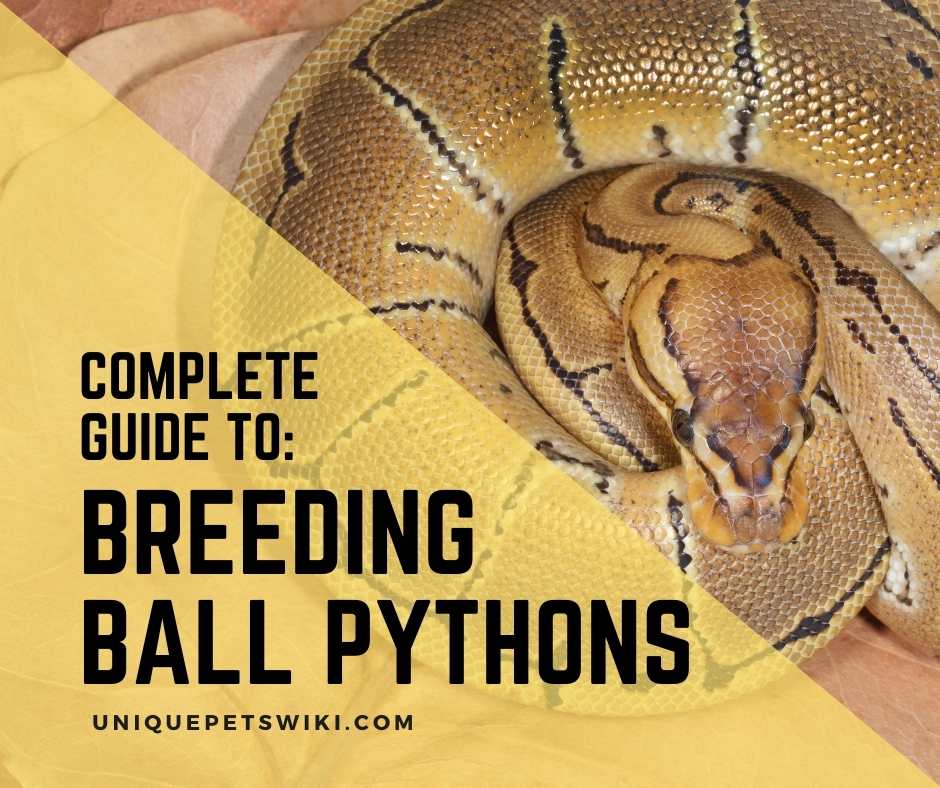The activity of ball python breeding in captivity started some 50 years ago. This is the same period the snakes were exported from their native habitat in West Africa to the pet trade in the United States.
This was when the snakes were considered as pets in the United States. Because of their docile nature, beautiful patterning, and small size they were desirable as pets. But even at that, they had a problem of feeding which makes caring for them cumbersome.
Apart from feeding issues, they came with loads of parasites and ticks. Perhaps this was one of the reasons they refuse to eat. Once breeding them in captivity took place shortly after that, not only reptile lovers desire to own ball pythons as pets, they now became popular.
The activity of breeding ball pythons is an exciting and adventurous one. However, you need a good knowledge of the subject to breed them successfully.
Whether you’re looking forward to breeding them for profit or just to increase your husbandry, you need to be good at it. How successful a breeder you are is a factor of what you know about breeding ball pythons and how well you take precautions.
Having said that, this article promises to take you through everything you need to know to successfully breed ball pythons. You’ll learn:
- How to tell if your snakes are ready to be bred.
- How to sex your breeding ball pythons to ensure that you pair the right sex.
- How to prepare the breeding snakes before pairing.
- How to collect and incubate the eggs, and
- How to care for your hatchlings.
Contents
- What You Need To Know Upfront Before Breeding Ball Pythons
- Identify Your Purpose For Breeding
- Probe Your Ball Pythons To Determine The Sex
- Your Snakes Must Be In Good Health
- The Breeding Pair Must Be Sexually Mature
- Ensure It Is Legal To Breed In Your State
- Can A Male And Female Ball Python Live Together?
- How Old Does A Ball Python Have To Be To Breed?
- How Many Eggs Does A Ball Python Lay At One Time?
- Do Ball Pythons Have A Breeding Season?
- How Long After Mating Does A Ball Python Lays Eggs?
- How To Breed Ball Pythons In 15 Steps
- Ensure They Are Fully Mature
- Prepare Your Snakes For Breeding
- Introduce The Male To The Female (Pairing)
- Making A Nest Site/An Egg-Laying Box For Your Ball Python
- Introducing Male To Females For Breeding
- What Do Ball Pythons Mating Behavior Look Like?
- How To Tell If A Ball Python Is Gravid (Pregnant)
- How Long After Mating Will Ball Pythons Lay Eggs?
- Ball Pythons Laying Eggs
- Collecting Laid Eggs And Transferring Them To An Incubation Box Or Incubator
- Incubate Ball Pythons
- What To Remember When Taking Care Of Baby Ball Pythons
- Conclusion
What You Need To Know Upfront Before Breeding Ball Pythons
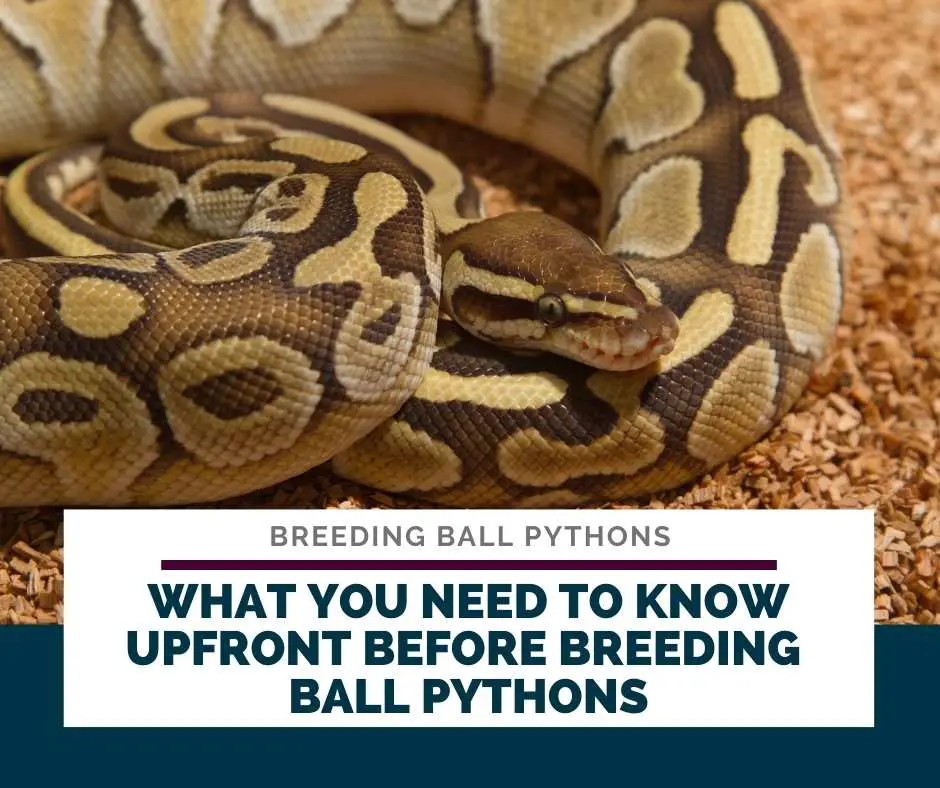
Identify Your Purpose For Breeding
Do you want to start a business around breeding ball pythons? Are you just breeding to increase your collection of ball pythons? Or do you want to breed to create a design morph?
Whatever is your reason or goal, there is an approach to follow for optimal results. Before you start, the first thing you should do upfront is to answer the question of why you want to breed your snake?
If you can tell why then it’ll guide you on the best technique to adopt. While it is simpler to casually breed your ball pythons, it is tasking to breed them with the aim to create a specific design ball python morph. It is also demanding to go into it as a full-time business.
First, you’ll need to understand the genetic makeup (DNA) of the snakes you intend to breed. Besides, you’ll have to understand how to calculate your chances of getting your desired result.
Aside from this, you’ll also need to know how to match the breeding snakes. This is a very important aspect for full-time breeders. Having a good knowledge of it will ensure you don’t create an endangered morph. For instance, a morph with wobbles.
Once your goal is set, the next thing is to factor in how you would care for the hatchlings. Your snake will likely lay a large clutch of 11 eggs at a time. What do you want to do with them?
You have to consider the cost of feeding these numbers of babies. Baby ball pythons can be voracious eaters. At this stage, they can eat up to two rats in a week. Apart from this, know that these hatchlings will need separate enclosures.
Each of these enclosures will need proper lighting, heating, humidity, and other essential accessories. This may not mean anything if you were to provide for one snake. But for newborns numbering 11, it’ll require a big sum.
Therefore, if you aren’t prepared for this kind of expenses, needless breeding ball pythons. While breeding ball pythons can be an exciting activity, it is expensive and tasking.
Probe Your Ball Pythons To Determine The Sex
Before you start breeding your snake, determine the sex of your breeding pair. Many breeders find this confusing or difficult. Wrong sexing is a common mistake made by breeders, especially beginners.
I believe you wouldn’t want to pair two snakes of the same gender together. To avoid this from happening you have to sex your snakes properly to tell which is male and female.
Determining the sex of your ball pythons isn’t easy. But there are easy-to-follow methods you can use to get results. Note that while sexing your ball python, if you don’t do it well you can inflict serious damage to the snakes’ reproductive systems. Read more for an easy to follow guide on sexing.
Your Snakes Must Be In Good Health
Another thing to take into consideration is the health of your snakes. During breeding season ball pythons usually have less appetite for food. That is why they lose some weight during the breeding process.
If your breeding snakes have some health issues, breeding them will exacerbate the problems. That said, before breeding your snakes, be sure that they are in good health.
One way to ensure they are in good health is to consult a vet who will do a medical checkup on them. Once they are free from diseases, they are good to be bred.
The Breeding Pair Must Be Sexually Mature
Once you’re sure that your breeding pair are healthy, they must be mature to start breeding. By this, it means that they must attain a breeding age and weight.
Note that when determining maturity, you don’t check their weight and age in isolation. You must take the two into consideration at the same time.
While some snakes can attain a breeding weight faster, that doesn’t mean they should be bred. If they haven’t reached breeding age, for their health’s sake allow them to grow. Age or weight alone does not determine maturity for breeding ball pythons.
Ensure It Is Legal To Breed In Your State
Depending on your objective for wanting to breed, you need to know the law surrounding it in your state. In some states, the breed and sale of ball pythons is illegal. While in some states you need a license to practice.
You may be lucky not to have restrictions in your current state. However, to be on the safe side you need to find out. This is because ball pythons are listed under the Animal Welfare Act (AWA).
However, regulations on ownership and breeding are different from states to states. Read through for a comprehensive list of states without restriction breeding ball pythons.
Can A Male And Female Ball Python Live Together?
Keeping more than one ball python in a tank is not ideal. The two snakes can fight and injure themselves. Besides, the snakes will become stressed and may refuse to eat.
The only period a male and female ball python should be housed together is during breeding. On conditions that you don’t intend to breed your female ball python, do not get her a roommate.
How Old Does A Ball Python Have To Be To Breed?
With ball pythons, the weight of the breeding snake matters more than the age. But the age is also taken into consideration when deciding if your ball pythons are ready for breeding.
This is because a well-fed ball python can attain a breeding weight within a short time although the snake is not fully mature or ready for breeding. Before breeding your female ball python, she should be at least 1200g.
A well-fed female ball python will attain this weight within 2years of age. The male ball pythons are much smaller in size and they attain sexual maturity faster than the females.
Ideally, a male ball python should get to at least 700g before pairing it for breeding. Even with this weight, the male ball python should be at least 12months old.
How Many Eggs Does A Ball Python Lay At One Time?
Ball pythons lay large clutches of eggs. In one breeding season, the breeding females lay only one large clutch. Inside a clutch, the number of eggs varies with individual snakes ranging between 3-11 eggs.
On average, a healthy female ball python will lay a clutch of about 6 eggs at a time. After the snake has successfully laid the eggs, how many eggs from the clutch successfully hatch is a factor of the circumstances surrounding it. Some eggs may not hatch if you don’t handle it properly.
Do Ball Pythons Have A Breeding Season?
Ball pythons are not like mammals when it comes to reproduction. They have a specific time of the year which the male and the female mate reproduce. This period is called ball python Breeding Season.
In the wild, this season usually falls in the colder period or rainy season of the year. It is between the months of September and November. In captivity, this season varies a lot with individual breeders.
Some breeders start preparing their female ball pythons for breeding from October spanning to March. Depending on your location and when you normally have your rainy season, you can decide to breed your female snake at that time.
The bottom line is that the temperatures in which your breeding female is kept should simulate the wild. This is because the breeding process for ball pythons is highly dependent on temperature.
During the cooler months, ball pythons in the wild will often copulate. However, the copulation at this time doesn’t get the females gravid. It is only considered as the preparation process. The copulation that leads to pregnancy occurs when the temperature warms up again.
How Long After Mating Does A Ball Python Lays Eggs?
After a successful mating, your gravid female ball python will ovulate to give the sign that she’s pregnant. She will be pregnant for about 4-5 weeks. During this period, she’ll have a pre-lay shed followed by a drop of her last urate and fecal matter.
This is the final sign that will tell you that she’ll soon lay eggs. 3 weeks after her pre-lay shed and final fecal droppings, she’ll lay a large clutch of eggs.
How To Breed Ball Pythons In 15 Steps
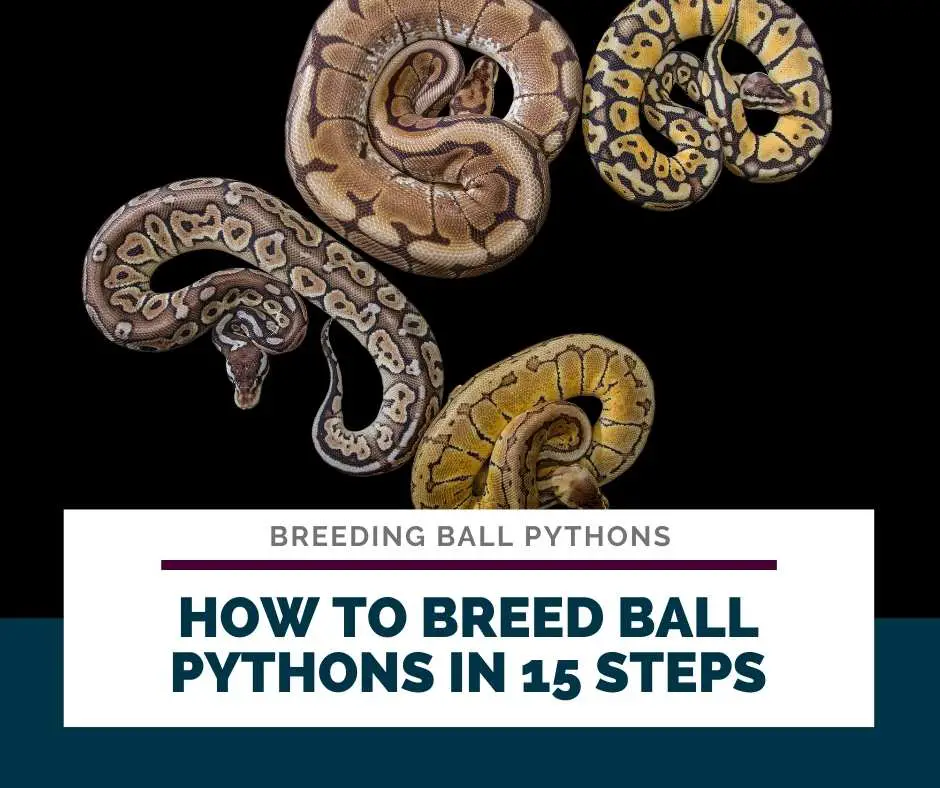
Whether you want to start breeding for profit or just looking at multiplying your collection, breeding ball pythons is an exciting and rewarding adventure. It is also one of the most crucial and delicate parts of their lives.
You should ensure that the entire process is carried out with due diligence. This is to ensure the safety of both the breeding adults and the eggs. The goal of this section is to give you a detailed guide to successfully breed your ball pythons from start to finish.
Breeding ball pythons isn’t difficult if you understand the basic processes involved. Many breeders who breed ball pythons for-profit use different techniques to get their desired results.
By this, one of the best that guarantees optimum results is placing your breeding adult pythons on a yearly or two-year breeding cycle. Besides, this will give room for your breeding female to gain back some weight that she lost from the previous breeding season.
Ensure They Are Fully Mature
As mentioned earlier, the first thing you’ll have to do is to ensure that your breeding snakes are fully mature. By maturity, their weight and age determine if they are fit to be paired for breeding.
The males must be at least 12months old and must have attained at least 700g in weight. The females who are to bear the brunch of breeding must weigh more than the males. Your breeding females must weigh at least 1200g and should be at least 2 years old.
Prepare Your Snakes For Breeding
To spark off breeding behavior in your breeding females, give it a cooling-off period of about 1-3 months. Dropping the temperature in their habitats simulates the colder periods in the wild. This change in temperature will signal them that it’s time to breed.
Since this period is naturally their breeding season, if you pair them up they’ll start to copulate. The ambient temperature in their terrarium at this time should not be higher than 70° F at night. During the day, the temperatures can be returned back to normal.
Ideally, the terrarium should be kept cool at night to mimic their natural habitat. After the 3 months cooling-off period, return all temperature (day and night) to normal.
Generally, male ball pythons display a lack of interest in females. While other species like corn snakes will hook up easily with the females, ball pythons need a push into action.
To spark this interest, you’ll need to put your male in a cage with other males. This will give him a little push. Once this is done, all the snakes will start to take notice of themselves and be in a defensive mood.
This defensive vertical stance usually lasts a few moments of about 20 minutes or less. When this happens, the males will become interested in females.
Introduce The Male To The Female (Pairing)
During the cooling period, you can introduce your already excited male to the female tank. In situations that you do not have other males to stimulate your breeding male sexually, pair him that way to the female.
Initially, the two snakes can fight. It is normal, but they will eventually get along and start to copulate. Once you notice that the two snakes have started to copulate, let them be. Avoid distracting them at this time.
Making A Nest Site/An Egg-Laying Box For Your Ball Python
When your snake is ready to lay her eggs, you’ll notice her pacing around the enclosure. She usually does this in search of a comfortable spot to lay her eggs. Prior to this time, prepare a laying nest for her. Get a box and fill it with some damp moss.
The moss serves as a substrate on which she will lay the eggs. Place the box on the warm side of the enclosure. When choosing your laying box, ensure that it’s wide enough to allow easy entrance for your snake. At the same time, you should be able to get access too. When she has successfully laid, transfer the eggs to your already prepared incubator.
Substrates For An Egg-Laying Box
All through my several years of experience and interactions with other breeders, I’ve found out that there are many different kinds of substrates used for the egg-laying box. There also exist different methods of using these substrates.
Some breeders have had a 100% hatch rate using only water and diffuser. Some others use the same beddings they use in their enclosure to prepare the egg-laying box. While it’s also common to see breeders use peat moss probably because it’s cheap and comes handy.
In a nutshell, the most commonly used and result proven egg-laying substrates are the vermiculite, hatchrite, and perilite. These substrates give no issues to your eggs. They’ll hatch the eggs with no mold dictated.
As for using only water and diffuser, the only advantage I can say is that it eliminates the error that is bound to occur in mixing other types of substrates.
Introducing Male To Females For Breeding
Note that the first pairing was part of their preparation process. That wouldn’t get the female gravid yet. It is the second introduction (pairing) that you’ll have a greater chance of having a gravid female.
On the second introduction, your male ball python will go straight up to copulate with the female. They will remain like that for at most 4 days. As a rule of thumb, avoid disturbing or distracting this process.
Once they feel disturbed, they’ll disconnect from each other. If that should happen, that means the mating wasn’t successful. Without distraction, the moment your snakes are done mating, give them time to rest and regain their strength.
You’ll know they are done mating when they disconnect from each other on their own. The resting period is very important if you have the need to pair the same male with another female.
What Do Ball Pythons Mating Behavior Look Like?
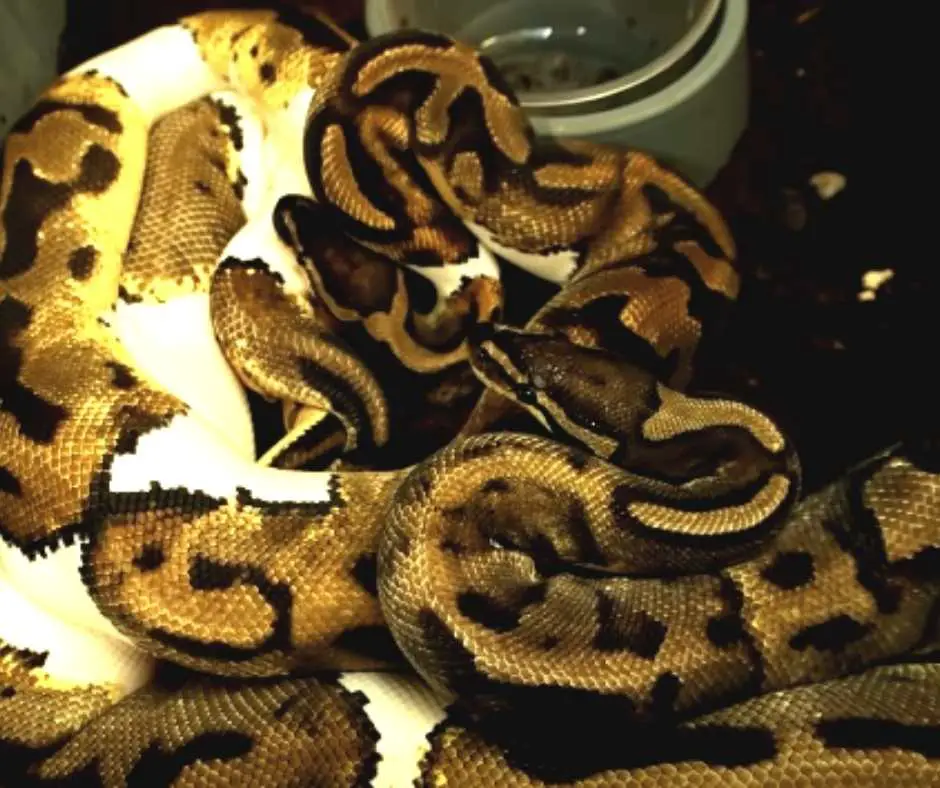
(Image Source: Olympus Reptiles)
There isn’t any standard mating behavior in ball pythons. How your ball python behaves will likely be different from how mine behaves. It’s more an individual snake thing than a conventional thing.
No two ball pythons are the same when it comes to personality or courting behavior. But a few consistent behaviors have been observed across snakes both in the wild and in captivity. One such behavior is Lack Of Interest In Food.
Once ball pythons start breeding (copulating), they will refuse to eat until the entire process is completed. Some female ball pythons will still eat once in a while but not regularly.
Tickling With Spurs
During courtship, the males usually tickle the females with their spurs to get them interested in mating. Never will you see a female do this to the male.
Thus, if you notice this behavior in your two snakes after pairing them together, don’t get too excited. The simple explanation is that both snakes are males. That is why probing your breeding pair is very important before breeding them.
Tail Wagging
Your male ball python may wag his tail when introduced to the female. But this is a behavior commonly displayed by the females. The females do this to tell the male that they are ready.
Sometimes the female will lift her tail and empty some of the tissues in her cloaca. You’ll know that you paired two snakes of the same sex together if they fight and never lock up.
Peeing And Scenting Around
This behavior is peculiar to the females. To signal the male that they are ready to breed, they would normally pee and scent around the male.
How To Tell If A Ball Python Is Gravid (Pregnant)
As a breeder, you’re similar in many ways to an expectant mother. You’ll expect to have a gravid female after a successful mating. But telling if your snake is gravid can be confusing. To make this simple, here are what to look out for in a gravid female ball python.
Thickening Of The Body
On the first account, there’ll be a bulge in the midsection of your snake. This is usually accompanied by an overall thickening of the body. This is one of the most common and easiest ways to tell that your female is gravid.
You’ll notice that the part of her body before the tail becomes swollen. The scales on that region will slightly flare outward to accommodate the bulge.
However, prior to this time, your snake must have ovulated during courting. Ovulation takes place before pregnancy. Signs of ovulation are even more prominent than pregnancy itself.
Ovulation is the period or process where the female releases all the eggs stored in her ovary at once. These eggs will be moved to the oviduct where they can be fertilized by the male sperm during mating.
Once this happens, you’ll notice a sizable lump in the midsection of her body. This sign is always so obvious as though she swallowed an over-sized rat. The bulge will stay that way for about 24 hours.
Change In Color
Another sign to tell that your female is pregnant is a slight change in color. Your snake can go from brown to very dark brown. The light-colored snakes will change to a lighter color.
For ball pythons with color mutations, when gravid the color will likely change dramatically. In a nutshell, what color a gravid ball python changes to depends on her main color or color morphs.
Behavior Change (Inverted Basking)
There is also a behavior change in gravid ball pythons. It is common to have gravid female ball pythons lay with their backs on the ground. This is referred to as an inverted basking. This way, they expose their stomach to the air.
This weird behavior often raises panic among breeders, especially first time breeders. Outside pregnancy, this behavior is an abnormal behavior that should be taken seriously. But once your female ball python is gravid you’ll likely see this behavior more often.
Pacing
Here you’ll agree that pregnancy takes a serious toll on ball pythons just like with humans. Throughout the entire process of egg formation and development, their body temperature is so unstable.
To regulate their temperature, they would often seek a comfortable spot to lie. Because of this, you’ll notice your gravid female moving around the enclosure finding a comfortable place to lie. You would also notice the snake trying to lie in different positions.
Lack Of Interest In Food
Another sure-fire sign that your female is pregnant is a lack of appetite. Since their stomach is already filled with eggs, they’ll often refuse to eat.
Take It To A Vet
If all the aforementioned cues are still confusing to you, take your snake to the vet. This is the final and surest way to tell if your ball python is gravid. However, this may not be necessary since you intentionally breed her.
The only condition you can opt for taking your bred female to the vet to confirm pregnancy is if you suspect any health issue. Other than that a gravid female will lay eggs 4-5 weeks after ovulation or mating.
How Long After Mating Will Ball Pythons Lay Eggs?
As earlier elaborated, ball pythons will lay eggs approximately 4-5 weeks after mating. This is after they have had their prey-lay shed and last fecal droppings. Once you notice these signs, you should be expecting some eggs 3 weeks later.
Ball Pythons Laying Eggs
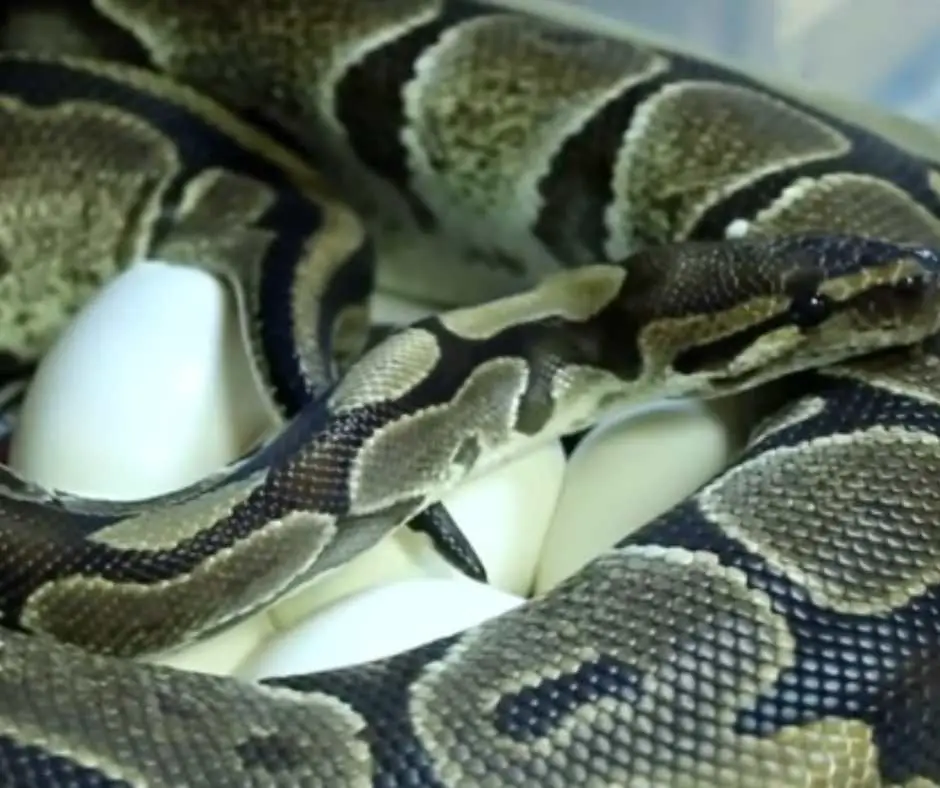
(Image Source: Reptile’s Story)
As it gets closer to birthing time, your gravid female will normally become restless. She’ll pace around the enclosure even more aggressively looking for a comfortable place to lay her eggs.
You have to ensure that she has a good place to lay her eggs. This is very important for a healthy laying process. The laying box should be placed in the warm area of the enclosure.
Note that the substrate used for the egg-laying box should be dampened. That said, keep in mind that the box should not be too wet. If the laying spot is too dry or too wet it’ll damage the eggs.
Just before your snake lays, you can feed her so she would gain some strength. After she has successfully laid her eggs, she’ll wrap herself around them. Gently unwrap her and transfer the eggs to an incubator.
Collecting Laid Eggs And Transferring Them To An Incubation Box Or Incubator
No living creature like intruders messing with their newborns. The same goes for ball pythons. In the wild when they’re done laying the eggs, they’ll coil around them till they hatch.
When they’re in this manner they’ll be very aggressive and protective of their eggs. Thus to remove her from the box, you must be careful. In the process, she will definitely hiss, protest, and try to stop you.
It’s normal for her to behave that way but you must not show panic. Hold her by the neck and remove her to another cage. Now you can conveniently transfer the eggs to an incubator.
To ensure that you don’t damage the eggs, you must adhere to precautionary measures here. Important points to note are:
- The side of the eggs facing up must be maintained in the incubator. To achieve this, you can mark the side facing up with a marker. This will help you to maintain that position when transferring them to the incubator.
- As mentioned earlier, do not flip or toss the eggs in the process of moving them. If this happens, it will cause issues to the developing snakes.
- While moving the eggs, if you notice some eggs stuck together, do not try to separate them. If you make such mistakes, the snakes will just die.
Once you’ve separated the snake from the eggs, you have to get her re-accustomed to her habitat. Without doing this she’ll still be feeling that she is breeding. You will constantly see her wrap herself around her water dish or a heap of beddings thinking that it’s her eggs.
When she’s still feeling this way, she’ll not want to eat. To get her re-acclimated to her habitat, you must eliminate all traces of the birth and scent of eggs from her. You can only do this by washing her thoroughly in warm soapy water. Also clean and fumigate her enclosure very well if she’s still using her old cage.
Incubate Ball Pythons
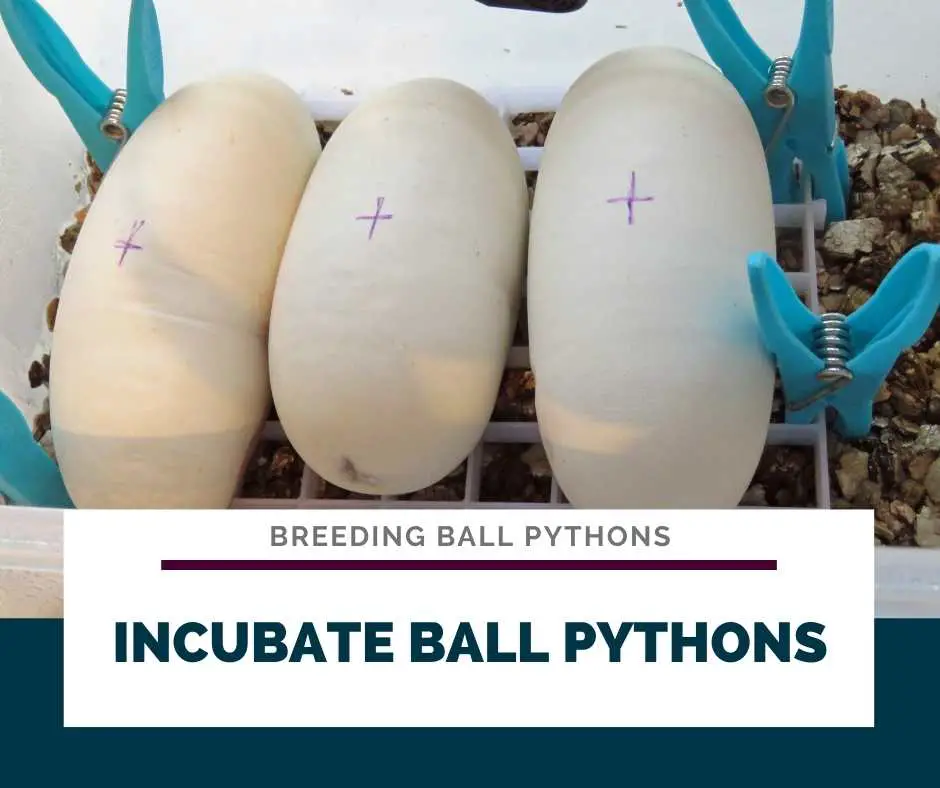
Incubating the eggs can be done in two ways. You can decide to let your female incubate them naturally by curling around the clutch or incubating them in an incubator. If you trust your female enough to handle it, you can give it a shot.
But the best way is to incubate them artificially in an incubator. For your incubator, you can use hatchrite, vermiculite, or perilite. Most successful breeders use a perilite incubator because it is pre-moistened and easier to use.
Read up for an easy step by step method to develop an incubator. Whatever you’re using as your incubator, the most important thing is to maintain a temperature and humidity of 88° F. In about 80 days maximum, the eggs will begin to hatch.
How Long Does It Take For An Egg To Successfully Hatch?
All conditions properly maintained, a viable egg will begin to hatch in approximately 50-55 days. At most, every egg in the clutch should hatch in 80 days.
Signs Of A Fertile Ball Python Egg
It’s easy to spot a healthy egg from the clutch just like a dead egg will stand out. A fertile ball python egg is white in color. When felt with the fingers, it has a leathery texture.
It is slightly bigger than the size of a poultry bird’s egg. Anything other than this is an unfertilized egg (dead egg).
Signs Of A Dead Ball Python Egg
An unfertilized ball python egg will appear smaller in size than the fertile eggs. They are called slugs. They look a bit discolored (yellowish in color) and have pointed ends.
When felt with the fingers they feel like a deflated tire (tube). You’ll have this kind of egg in your clutch if you try breeding an immature female ball python.
What To Remember When Taking Care Of Baby Ball Pythons
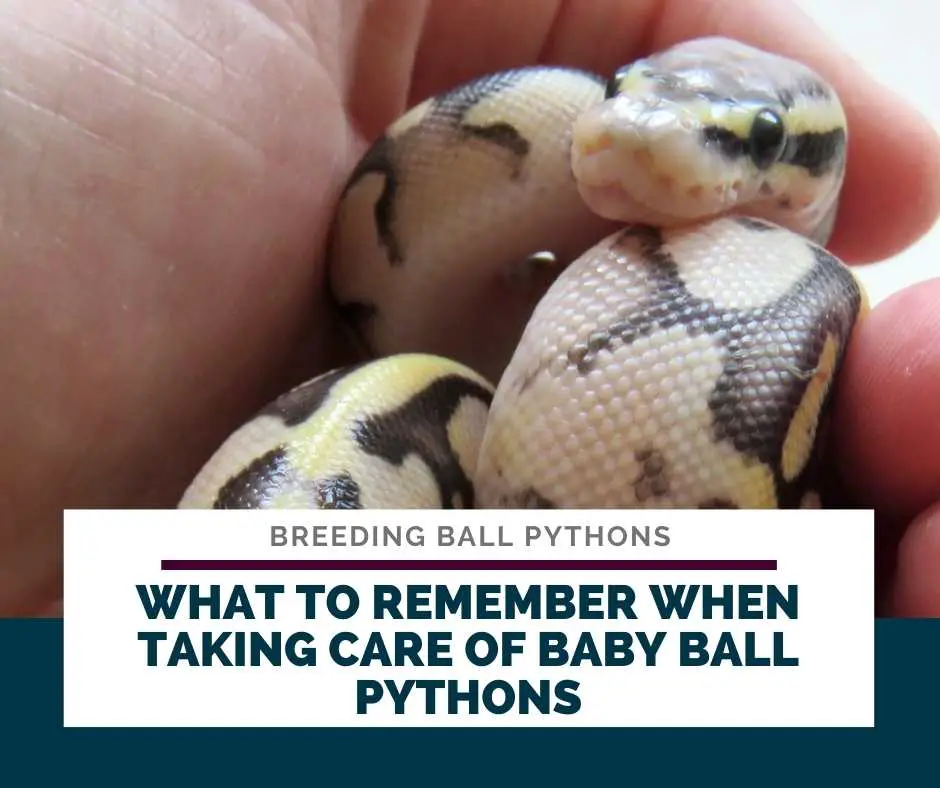
Watch Out For First Shed
The incubation process takes approximately 80-105 days. In the wild, once this period approaches, the mother snake will leave the eggs to hatch and fend for themselves. Thus, for your pet snake, do not try to help the eggs to hatch.
If you do that you’ll damage the development process of the hatchlings. When the eggs have successfully hatched, the hatchlings will not eat instantly.
They only have an interest in food after their first shed. For your newborns, you’ll have to watch out for their first shed before offering food.
Limit Handling Or Social Interaction
Ball pythons do not need social interaction to stay healthy. But you’ll need to handle them from time to time so that they can get used to you.
It’s ideal to handle them 1-2 times a week. But avoid handling them too often (like handling them several times in a day).
Get Them Separate Enclosures
Although ball pythons are shy when they’re still hatchlings, it is not ideal to house all of them in one cage. You may do this pending when they had their first shed, but even at that, you will find it difficult to tell which snake has shed or not.
The ideal thing is to get them separate enclosures to live in. to offer them proper habitat to thrive in, ensure you provide all necessary accessories and temperatures.
Conclusion

Breeding your female ball python isn’t a bad idea. You would enjoy being a part of bringing new snakes to the ecosystem. However, taking care of the large clutch that will be delivered to you is where you’ll find tasking.
I always advise new breeders, if you aren’t prepared to care for hatchlings as many as 11, do not think of breeding ball pythons.
Nonetheless, this is not to scare you from venturing into ball python breeding. The rule of thumb is that you should understand the processes involved in breeding ball pythons. Besides, ensure that the health of your breeding female isn’t at stake.
